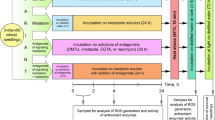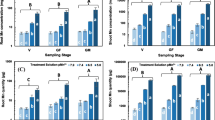Abstract
Nitric oxide (NO) is a bioactive gas and functions as a signaling molecule in plants exposed to diverse biotic and abiotic stresses including cadmium (Cd2+). Cd2+ is a non-essential and toxic heavy metal, which has been reported to induce programmed cell death (PCD) in plants. Here, we investigated the role of NO in Cd2+-induced PCD in tobacco BY-2 cells (Nicotiana tabacum L. cv. Bright Yellow 2). In this work, BY-2 cells exposed to 150 μM CdCl2 underwent PCD with TUNEL-positive nuclei, significant chromatin condensation and the increasing expression of a PCD-related gene Hsr203J. Accompanied with the occurring of PCD, the production of NO increased significantly. The supplement of NO by sodium nitroprusside (SNP) had accelerated the PCD, whereas the NO synthase inhibitor Nω-nitro-l-arginine methyl ester hydrochloride (l-NAME) and NO-specific scavenger 2-(4-carboxyphenyl)-4,4,5,5-tetramethylimidazoline-1-oxyl-3-oxide (cPTIO) alleviated this toxicity. To investigate the mechanism by which NO exerted its function, Cd2+ concentration was measured subsequently. SNP led more Cd2+ content than Cd2+ treatment alone. By contrast, the prevention of NO by l-NAME decreased Cd2+ accumulation. Using the scanning ion-selective electrode technique, we analyzed the pattern and rate of Cd2+ fluxes. This analysis revealed the promotion of Cd2+ influxes into cells by application of SNP, while l-NAME and cPTIO reduced the rate of Cd2+ uptake or even resulted in net Cd2+ efflux. Based on these founding, we concluded that NO played a positive role in CdCl2-induced PCD by modulating Cd2+ uptake and thus promoting Cd2+ accumulation in BY-2 cells.










Similar content being viewed by others
Abbreviations
- PCD:
-
Programmed cell death
- NO:
-
Nitric oxide
- SNP:
-
Sodium nitroprusside
- l-NAME:
-
Nω-Nitro-l-arginine methyl ester hydrochloride
- cPTIO:
-
2-(4-Carboxyphenyl)-4,4,5,5-tetramethylimidazoline-1-oxyl-3-oxide
- SIET:
-
Scanning ion-selective electrode technique
References
Behboodi BS, Samadi L (2004) Detection of apoptotic bodies and oligonucleosomal DNA fragments in cadmium-treated root apical cells of Allium cepa Linnaeus. Plant Sci 167:411–416
Beligni MV, Lamattina L (2000) Nitric oxide stimulates seed germination and de-etiolation, and inhibits hypocotyl elongation, three light-inducible responses in plants. Planta 210:215–221
Besson-Bard A, Wendehenne D (2009) Nitric oxide contributes to cadmium toxicity in Arabidopsis thaliana by mediating an iron deprivation response. Plant Signal Behav 4:252–254
Besson-Bard A, Gravot A, Richaud P, Auroy P, Duc C, Gaymard F, Taconnat L, Renou JP, Pugin A, Wendehenne D (2009) Nitric oxide contributes to cadmium toxicity in Arabidopsis by promoting cadmium accumulation in roots and by up-regulating genes related to iron uptake. Plant Physiol 149:1302–1315
Cohen CK, Fox TC, Garvin DF, Kochian LV (1998) The role of iron-deficiency stress responses in stimulating heavy-metal transport in plants. Plant Physiol 116:1063–1072
Connolly EL, Fett JP, Guerinot ML (2002) Expression of the IRT1 metal transporter is controlled by metals at the levels of transcript and protein accumulation. Plant Cell 14:1347–1357
De Michele R, Vurro E, Rigo C, Costa A, Elviri L, Di Valentin M, Careri M, Zottini M, di Toppi LS, Lo Schiavo F (2009) Nitric oxide is involved in cadmium-induced programmed cell death in Arabidopsis suspension cultures. Plant Physiol 150:217–228
Delledonne M, Xia YJ, Dixon RA, Lamb C (1998) Nitric oxide functions as a signal in plant disease resistance. Nature 394:585–588
di Toppi LS, Gabbrielli R (1999) Response to cadmium in higher plants. Environ Exp Bot 41:105–130
Fojtova M, Kovarik A (2000) Genotoxic effect of cadmium is associated with apoptotic changes in tobacco cells. Plant Cell Environ 23:531–537
Fojtova M, Fulneckova J, Fajkus J, Kovarik A (2002) Recovery of tobacco cells from cadmium stress is accompanied by DNA repair and increased telomerase activity. J Exp Bot 53:2151–2158
Groppa MD, Rosales EP, Lannone MF, Benavides MP (2008) Nitric oxide, polyamines and Cd-induced phytotoxicity in wheat roots. Phytochemistry 69:2609–2615
Heath MC (2000) Hypersensitive response-related death. Plant Mol Biol 44:321–334
Hsu YT, Kao CH (2004) Cadmium toxicity is reduced by nitric oxide in rice leaves. Plant Growth Regul 42:227–238
Huang HE, Ger MJ, Yip MK, Chen CY, Pandey AK, Feng TY (2004) A hypersensitive response was induced by virulent bacteria in transgenic tobacco plants overexpressing a plant ferredoxin-like protein (PFLP). Physiol Mol Plant Pathol 64:103–110
Iakimova ET, Woltering EJ, Kapchina-Toteva VM, Harren FJM, Cristescu SM (2008) Cadmium toxicity in cultured tomato cells—role of ethylene, proteases and oxidative stress in cell death signaling. Cell Biol Int 32:1521–1529
Jarup L, Akesson A (2009) Current status of cadmium as an environmental health problem. Toxicol Appl Pharm 238:201–208
Kochian LV, Shaff JE, Kuhtreiber WM, Jaffe LF, Lucas WJ (1992) Use of an extracellular, ion-selective, vibrating microelectrode system for the quantification of K+, H+, and Ca2+ fluxes in maize roots and maize suspension cells. Planta 188:601–610
Laspina NV, Groppa MD, Tomaro ML, Benavides MP (2005) Nitric oxide protects sunflower leaves against Cd-induced oxidative stress. Plant Sci 169:323–330
Leonard EM, Pierce LM, Gillis PL, Wood CM, O’Donnell MJ (2009) Cadmium transport by the gut and Malpighian tubules of Chironomus riparius. Aquat Toxicol 92:179–186
Leshem YY, Wills RBH, Ku VVV (1998) Evidence for the function of the free radical gas—nitric oxide (NO·)—as an endogenous maturation and senescence regulating factor in higher plants. Plant Physiol Biochem 36:825–833
Locato V, Gadaleta C, De Gara L, De Pinto MC (2008) Production of reactive species and modulation of antioxidant network in response to heat shock: a critical balance for cell fate. Plant Cell Environ 31:1606–1619
Mata CG, Lamattina L (2001) Nitric oxide induces stomatal closure and enhances the adaptive plant responses against drought stress. Plant Physiol 126:1196–1204
McCabe PF, Leaver CJ (2000) Programmed cell death in cell cultures. Plant Mol Biol 44:359–368
Murphy ME, Noack E (1994) Nitric-oxide assay using hemoglobin method. Method Enzymol 233:240–250
Nagata T, Nemoto Y, Hasezawa S (1992) Tobacco BY-2 cell-line as the Hela-cell in the cell biology of higher-plants. Int Rev Cytol 132:1–30
Nawrot T, Plusquin M, Hogervorst J, Roels HA, Celis H, Thijs L, Vangronsveld J, Van Hecke E, Staessen JA (2006) Environmental exposure to cadmium and risk of cancer: a prospective population-based study. Lancet Oncol 7:119–126
Ormerod MG, Sun XM, Brown D, Snowden RT, Cohen GM (1993) Quantification of apoptosis and necrosis by flow-cytometry. Acta Oncol 32:417–424
Pence NS, Larsen PB, Ebbs SD, Letham DLD, Lasat MM, Garvin DF, Eide D, Kochian LV (2000) The molecular physiology of heavy metal transport in the Zn/Cd hyperaccumulator Thlaspi caerulescens. Proc Natl Acad Sci USA 97:4956–4960
Perfus-Barbeoch L, Leonhardt N, Vavasseur A, Forestier C (2002) Heavy metal toxicity: cadmium permeates through calcium channels and disturbs the plant water status. Plant J 32:539–548
Pineros MA, Shaff JE, Kochian V (1998) Development, characterization, and application of a cadmium-selective microelectrode for the measurement of cadmium fluxes in roots of Thlaspi species and wheat. Plant Physiol 116:1393–1401
Pontier D, Godiard L, Marco Y, Roby D (1994) Hsr203j, a tobacco gene whose activation is rapid, highly localized and specific for incompatible plant/pathogen interactions. Plant J 5:507–521
Pontier D, Tronchet M, Rogowsky P, Lam E, Roby D (1998) Activation of hsr203, a plant gene expressed during incompatible plant-pathogen interactions, is correlated with programmed cell death. Mol Plant Microbe Interact 11:544–554
Pontier D, Balague C, Bezombes-Marion I, Tronchet M, Deslandes L, Roby D (2001) Identification of a novel pathogen-responsive element in the promoter of the tobacco gene HSR203J, a molecular marker of the hypersensitive response. Plant J 26:495–507
Prado AM, Porterfield DM, Feijo JA (2004) Nitric oxide is involved in growth regulation and re-orientation of pollen tubes. Development 131:2707–2714
Shi SY, Wang G, Wang YD, Zhang LG, Zhang LX (2005) Protective effect of nitric oxide against oxidative stress under ultraviolet-B radiation. Nitric Oxide-Biol Chem 13:1–9
Singh HP, Batish DR, Kaur G, Arora K, Kohli RK (2008) Nitric oxide (as sodium nitroprusside) supplementation ameliorates Cd toxicity in hydroponically grown wheat roots. Environ Exp Bot 63:158–167
Singh HP, Kaur S, Batish DR, Sharma VP, Sharma N, Kohli RK (2009) Nitric oxide alleviates arsenic toxicity by reducing oxidative damage in the roots of Oryza sativa (rice). Nitric Oxide 20:289–297
Sun J, Chen SL, Dai SX, Wang RG, Li NY, Shen X, Zhou XY, Lu CF, Zheng XJ, Hu ZM, Zhang ZK, Song J, Xu Y (2009a) NaCl-induced alternations of cellular and tissue ion fluxes in roots of salt-resistant and salt-sensitive poplar species. Plant Physiol 149:1141–1153
Sun J, Dai SX, Wang RG, Chen SL, Li NY, Zhou XY, Lu CF, Shen X, Zheng XJ, Hu ZM, Zhang ZK, Song J, Xu Y (2009b) Calcium mediates root K+/Na+ homeostasis in poplar species differing in salt tolerance. Tree Physiol 29:1175–1186
Takahashi Y, Berberich T, Yamashita K, Uehara Y, Miyazaki A, Kusano T (2004) Identification of tobacco HIN1 and two closely related genes as spermine-responsive genes and their differential expression during the Tobacco mosaic virus-induced hypersensitive response and during leaf- and flower-senescence. Plant Mol Biol 54:613–622
van Doorn WG, Woltering EJ (2005) Many ways to exit? Cell death categories in plants. Trends Plant Sci 10:117–122
Verbruggen N, Hermans C, Schat H (2009a) Mechanisms to cope with arsenic or cadmium excess in plants. Curr Opin Plant Biol 12:364–372
Verbruggen N, Hermans C, Schat H (2009b) Molecular mechanisms of metal hyperaccumulation in plants. New Phytol 181:759–776
Wagner GJ (1993) Accumulation of cadmium in crop plants and its consequences to human health. Advances in agronomy, vol 51. Academic Press Inc, San Diego, pp 173–212
Wang YH, Chen T, Zhang CY, Hao HQ, Liu P, Zheng MZ, Baluska F, Samaj J, Lin JX (2009) Nitric oxide modulates the influx of extracellular Ca2+ and actin filament organization during cell wall construction in Pinus bungeana pollen tubes. New Phytol 182:851–862
Wendehenne D, Durner J, Klessig DF (2004) Nitric oxide: a new player in plant signalling and defence responses. Curr Opin Plant Biol 7:449–455
Xiong J, Lu H, Lu KX, Duan YX, An LY, Zhu C (2009a) Cadmium decreases crown root number by decreasing endogenous nitric oxide, which is indispensable for crown root primordia initiation in rice seedlings. Planta 230:599–610
Xiong J, An LY, Lu H, Zhu C (2009b) Exogenous nitric oxide enhances cadmium tolerance of rice by increasing pectin and hemicellulose contents in root cell wall. Planta 230:755–765
Yu CC, Hung KT, Kao CH (2005) Nitric oxide reduces Cu toxicity and Cu-induced NH4 + accumulation in rice leaves. J Plant Physiol 162:1319–1330
Yuan YJ, Ge ZQ, Li JC, Wu JC, Hu ZD (2002) Differentiation of apoptotic and necrotic cells in suspension cultures of Taxus cuspidata by the combined use of fluorescent dying and histochemical staining methods. Biotechnol Lett 24:71–76
Zhang HY, Xu WZ, Guo JB, He ZY, Ma M (2005) Coordinated responses of phytochelatins and metallothioneins to heavy metals in garlic seedlings. Plant Sci 169:1059–1065
Zhang F, Wang YP, Yang YL, Wu H, Wang D, Liu JQ (2007) Involvement of hydrogen peroxide and nitric oxide in salt resistance in the calluses from Populus euphratica. Plant Cell Environ 30:775–785
Zhang LR, Xu QX, Xing D, Gao CJ, Xiong HW (2009) Real-time detection of caspase-3-like protease activation in vivo using fluorescence resonance energy transfer during plant programmed cell death induced by ultraviolet C overexposure. Plant Physiol 150:1773–1783
Zonia L, Cordeiro S, Tupy J, Feijo JA (2002) Oscillatory chloride efflux at the pollen tube apex has a role in growth and cell volume regulation and is targeted by inositol 3,4,5,6-tetrakisphosphate. Plant Cell 14:2233–2249
Acknowledgments
The authors thank Prof. Xuejun Hua (Key Laboratory of Photosynthesis and Environmental Molecular Physiology, Institute of Botany, Chinese Academy of Sciences, China) for providing the BY-2 cells. This study was supported by the National Natural Science Foundation of China (90713030 and 30730009) and Hi-tech Research and Development Program of China (2007AA091704).
Author information
Authors and Affiliations
Corresponding author
Additional information
W. Ma and W. Xu contributed equally to this study.
Rights and permissions
About this article
Cite this article
Ma, W., Xu, W., Xu, H. et al. Nitric oxide modulates cadmium influx during cadmium-induced programmed cell death in tobacco BY-2 cells. Planta 232, 325–335 (2010). https://doi.org/10.1007/s00425-010-1177-y
Received:
Accepted:
Published:
Issue Date:
DOI: https://doi.org/10.1007/s00425-010-1177-y




